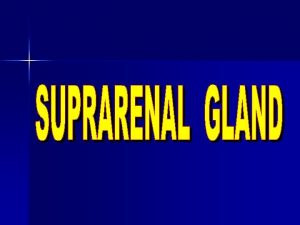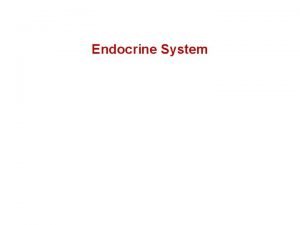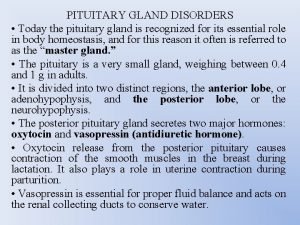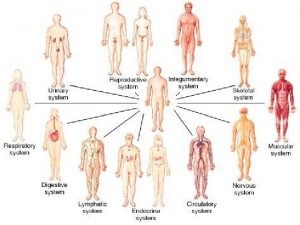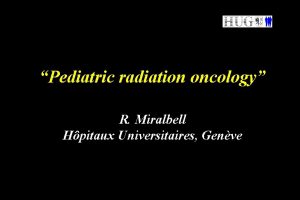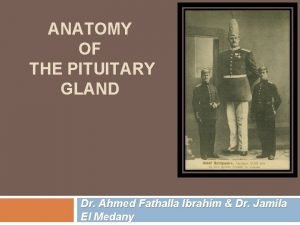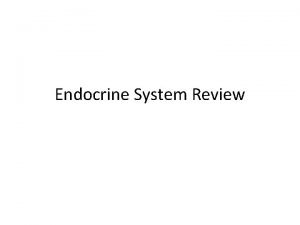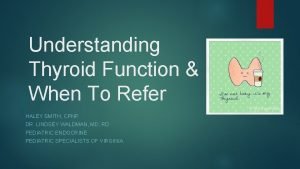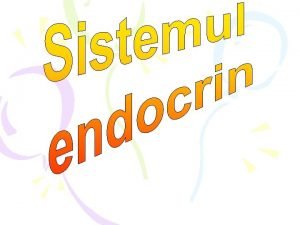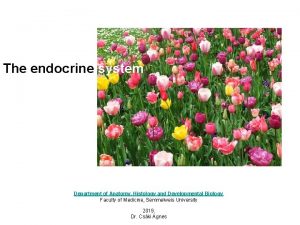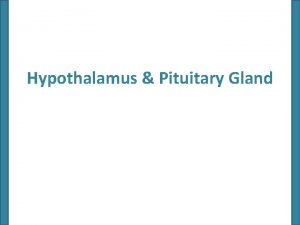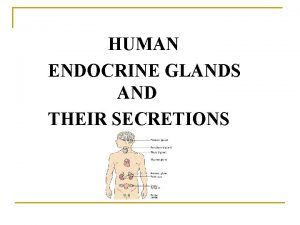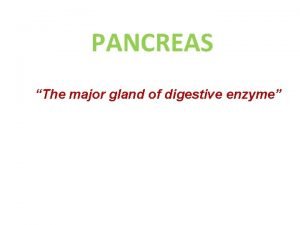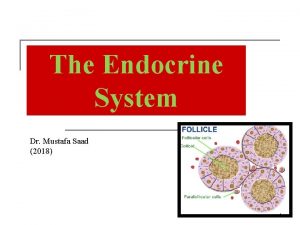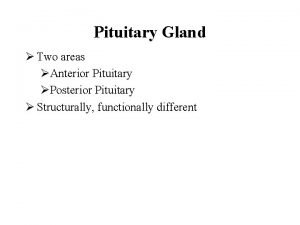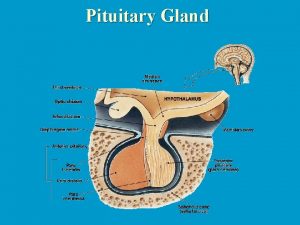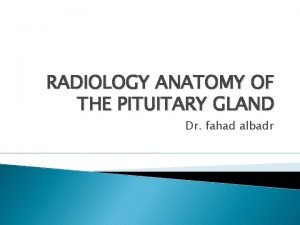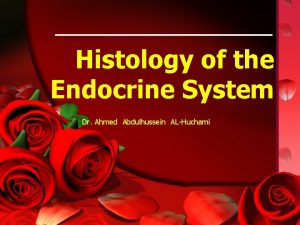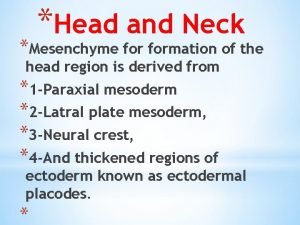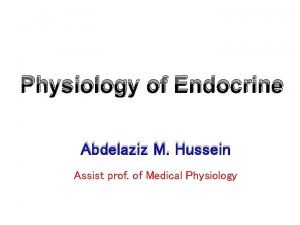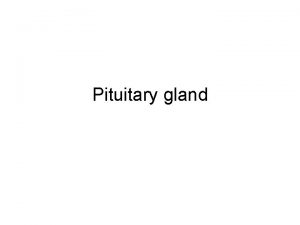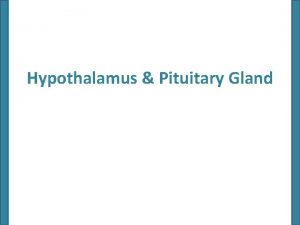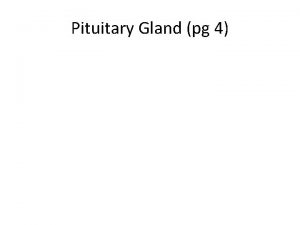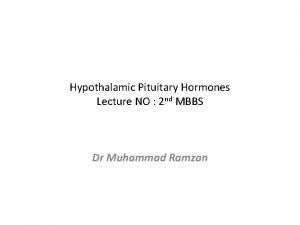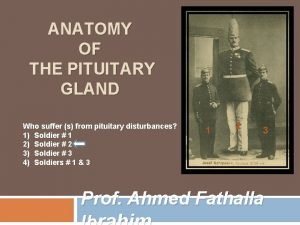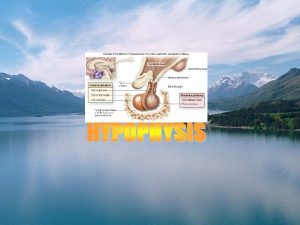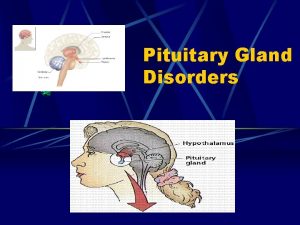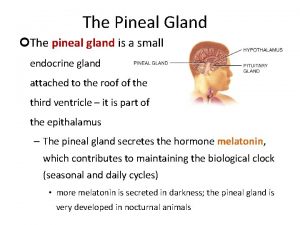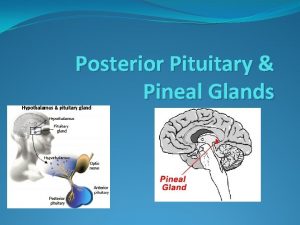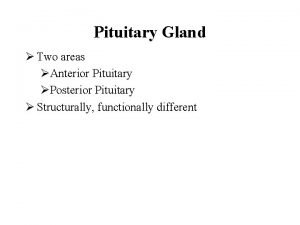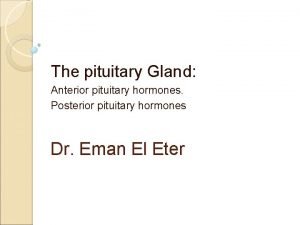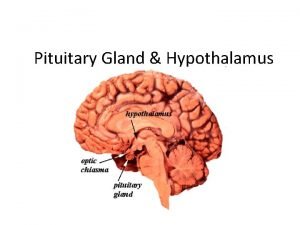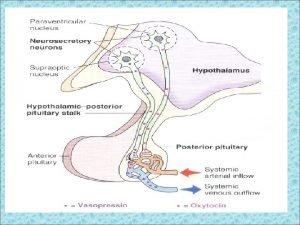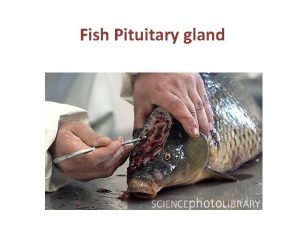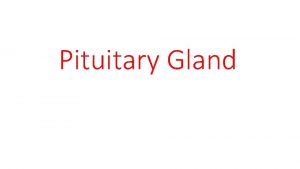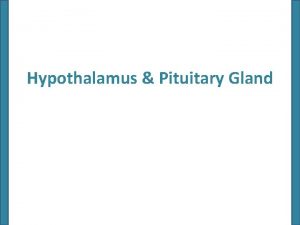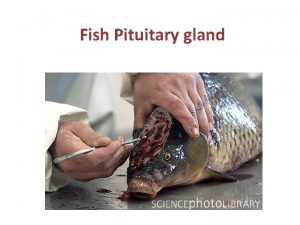I PINEAL GLAND PITUITARY GLAND THYOID GLAND 1




































- Slides: 36






I. 호르몬의 일반적 특성 PINEAL GLAND PITUITARY GLAND THYOID GLAND 1) 전엽: ACTH, TSH, GH PRL, FSH, LH, MSH 2) 후엽 : OXYTOCIN, ADH T 4, T 3, CT THYMUS ADRENAL GLANDS PANCREAS 1) 속질 : E, NE 2) 피질: Cortisol, corticosterone, cortisone, aldosterone, androgens TESTES Androgens, testosterone • Insuline, glucago n OVARY Estogen, progesterone • •




1. 호르몬의 기능 -growth & differentiation --- GH, IGF-1, thyroid Hr --- Sex Hr Maintenance of homeostasis Tyroid Hr --- basal metabolism in most tissues Cortisol --- permissive action PTH --- Ca 2+ & phosphate levels Vasopressin --- serum osmolarity Mineralocorticids --- vascular volume & serum electrolyte concentration Insulin --- blood glucose level Reproduction : sex Hr , EGF & IGF-1 , VEGF & PROSTAGLADINS, PROLACTIN, OXYTOCIN

2. 내분비계와 신경계의 특 성 Endocrine system Nervous system Mediator molecule hormone neurotransmitter Site of mediator action Usually far from site of release Close to site release Types of target cells Cells throughout the body Muscle cells, gland cells, other neurons Time to onset of action second to hours or days Typically within milliseconds Duration of action Generally longer(hours to days) Generally briefer(milliseconds)

3. 호르몬의 분류 해부적 -시상하부, 뇌하수체(전엽/후엽), 갑상샘, 부갑상샘, 췌장, 부신, 고환, 난소 심방, 송과체(솔방울샘), 위장관계, 지방세포, 신장, 태반 화학전 -아미노산 유도체: Catecholamines, thyroid Hr, Melatonin - 신경펩티드 : Gn. RH, TRH, somostatin, vasopressin - 단백질: insulin, LH, PTH - 스테로이드 : Cortisol, aldosterone, androgen, estrogen, progesterone - 비타민 유도체 : Vit. D , retinoids -지용성 : steroid Hr, thyroid Hr, nitric oxide - 수용성 : amine Hr , peptide& protein Hr, eicosanoids


4. 1 호르몬의 분류 Choleserol Pregneolone Progesterone 17 -OH-Pregnenolone Dehydroepiandrosterone Corticosterone Aldosterone 17 -OH-Progesterone Testosterone Cortisol Estradiol 스테로이드 호르몬의 합성 과정




4. 호르몬의 작용양상 Circulating hormone - endocrine Local hormone -paracrine - autocrine 그림 넣기

Signaling by secreted molecules 1. Endocrine- Cells in one part of the bodysend Hormone via the bloodstream to influence other parts 2 Paracrine – Cells secrete substances that influence other cells around them, by secrsting chemicals into the common intercellular space, important process during embryonic development 3. Autocrine – Cells secrets substance that influence themselves, a way for a cell to alter its own extracellular environment, important for growth




MEMBRANE RECEPTOR FAMIILIES AND SIGNALING PATHWAYS Receptor G protein-coupled seven transmembrane(GPCR) Β-Andrenergic LH, FSH, TSH Glucagon PTH, PTHr. P ACTH, MSH GHRH, CRH α- Adrenergic Somatostatin TRH, Gn. RH Receptor tyrosine kinase Insulin, IGF-I EGF, NGF Cytokine receptor – linked kinase GH , PRL Serine Kinase Activin, TGF-β, MIS Effectors G(α), adenylatecyclae Ca 2+ channels G(α) Tyrosine kinase, IRS-1 TO IRS-4 Tyrosine kinase, ras JAK, Tyrosine kinase SERINE KINASE Signaling Pathway









Intracellular nuclear receptor Homodimer Steroid Receptors ER, AR , PR, GR Heterodimer Receptor TR, VDR, RSR, PPAR Ligands DNA response elements Ligand induces coactivator binding ER : estrogen receptor AR : androgen receptor PR : progesterone receptor GR : glucocorticoid TR : thyroid hormone receptor VDR : vitamin D receptor RAR : retinoic acid receptor PPAR : peroxisome receptor proliferator activated receptor Ligand dissociates corepressors and induces coactivator binding Receptor – coactivator complex --- gene transcroption 1) recruitment of enzymess that modify chromatin structure 2) interactions with additional transcription factors on the target gene 30 direct interaction with components of general transcription apparatus to enhance the rate RNA polymerase II- mediated transcription


5. 1 수용성 호르몬 ① Binding of hormone(first messenger) to its receptor activates G protein, which activates adenylate cyclase ② Activated adenylate cyclase coverts ATP To Camp ③ Camp serves as a second messenger to activate protein kinases ④ Activated protein kinase phsphorylate cellular proteins ⑤ Millions of phosphorylated proteins cause reactions that produce physiological responses 그림 필요

5. 2 지용성 호르몬 그림넣기 ① Lipid – soluble hormon diffuses into cell ② Activated receptor-hormone complex alters gene expression ③ Newly formed Mrna directs synthesis of specific proteins on rebosomes ④ New proteins alter cell activity.

 Pituitary gland and pineal gland spiritual
Pituitary gland and pineal gland spiritual Pineal gland pituitary gland
Pineal gland pituitary gland Dopamine agonists
Dopamine agonists Seat of the soul pineal gland
Seat of the soul pineal gland Pineal gland secretes
Pineal gland secretes Parafollicular cells vs follicular cells
Parafollicular cells vs follicular cells Pineal gland target cells
Pineal gland target cells Pineal gland location
Pineal gland location Pituitary gland disorders
Pituitary gland disorders Human body
Human body Brainstem glioma
Brainstem glioma Diaphragma sellae
Diaphragma sellae Sketch of pituitary gland
Sketch of pituitary gland Pituitary gland thyroid
Pituitary gland thyroid Hormoni hidrosolubili
Hormoni hidrosolubili Pituitary gland inferior view
Pituitary gland inferior view Pituitary gland
Pituitary gland N
N Renal angle
Renal angle Hypophyseal fossa and pituitary gland
Hypophyseal fossa and pituitary gland Hypophyseal fossa and pituitary gland
Hypophyseal fossa and pituitary gland Embryonic development of pituitary gland
Embryonic development of pituitary gland Anterior pituitary gland
Anterior pituitary gland Oxytocin
Oxytocin Pituitary gland nerve supply
Pituitary gland nerve supply Dictalie
Dictalie Development of tongue
Development of tongue Morphology of pituitary gland
Morphology of pituitary gland Diaphragma sellae
Diaphragma sellae Pituitary gland embryonic origin
Pituitary gland embryonic origin Hypothalamus and pituitary gland connection
Hypothalamus and pituitary gland connection Pituitary gland hormones
Pituitary gland hormones Pituitary gland division
Pituitary gland division Colloid anatomy
Colloid anatomy Subdivision of pituitary gland
Subdivision of pituitary gland Endocrine weight loss
Endocrine weight loss Health concerns
Health concerns




